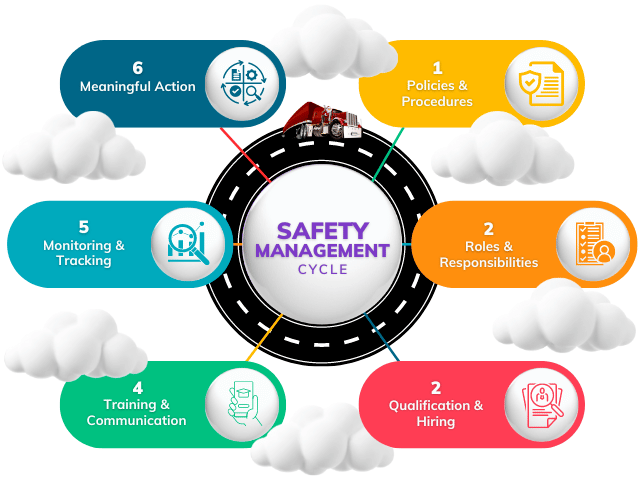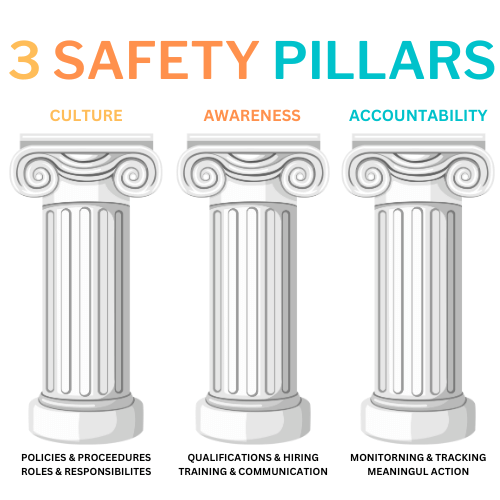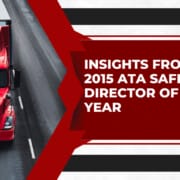Trucking Safety Program’s 3 Pillars of Success Video
About the Presenter
How would decreasing accident costs by $8400 per accident impact your company’s bottom line?
It equated to more than $330,000 per year for Allan Hicks, Vice President of Human Resources for BR Williams Trucking. He was able to accomplish this through awareness training using the Infinit-I Workforce System.
Named the 2015 ATA Safety Director of the Year, Allan is a big proponent of helping fleets improve their safety training programs. With more than 45 years of experience in the trucking industry, he has held various positions in management with large LTL carriers.
Expanded Overview of Trucking Safety Program
A robust Trucking Safety Program is essential for reducing accidents, lowering insurance costs, and improving overall fleet management. Allan Hicks, Vice President of Human Resources for BR Williams Trucking and 2015 ATA Safety Director of the Year, advocates for strong safety training programs. He successfully reduced accident costs by $8400 per accident using the Infinit-I Workforce System, equating to over $330,000 per year.
Simplifying Safety Fleet Management Using the Three Pillars of Safety
Every trucking company aims to minimize accidents and roadside violations through an effective safety program. The Three Pillars of Safety—Culture, Awareness, and Accountability—serve as a foundational process for building a strong Trucking Safety Program.
- Internal Values: Establish what the company’s Safety Culture should be.
- Safety Priority: Ensure safety is a top priority in decision-making processes.
- Departmental Views: Review how different departments perceive safety.
- Defining Acceptable Behavior: Create policies that define acceptable and unacceptable behaviors.
- Employee Involvement: Involve employees in policy creation for better “buy-in.”
- Regulatory Compliance: Ensure policies align with federal, state, and local regulations.
- Clarity: Clearly define roles and responsibilities within the policies.
- Job Descriptions: Include roles in job descriptions and update them as needed.
- Consistency: Ensure all employees understand their responsibilities to avoid confusion.
- Training: Conduct thorough training during orientation and ongoing sessions.
- Regulations: Keep employees updated on regulatory changes and new policies.
- Documentation: Document all training to support disciplinary actions if needed.
- Strict Hiring Criteria: Maintain high standards for hiring drivers to avoid future issues.
- Orientation: Clearly communicate expectations during the onboarding process.
- Continuous Evaluation: Retrain or terminate employees who fail to meet qualifications.
- Training Steps:
- Establish a “needs” analysis.
- Develop the training program.
- Deliver the training program.
- Evaluate and document the training.
- Modern Methods: Utilize web-based training for flexibility and accessibility.
- Review Compliance: Regularly review compliance with internal procedures and FMCSA regulations.
- Proactive Measures: Correct bad behaviors before they result in road incidents.
- Data Collection: Use telematics and software to collect and review data points.
- Trend Analysis: Identify and address negative trends promptly.
- Corrective Measures: Implement policies, training, or disciplinary actions to address areas needing improvement.
By following this structured approach, companies can create a world-class Trucking Safety Program that not only enhances safety but also contributes to the overall success and efficiency of the organization.
Building a Robust Trucking Safety Program for Trucking Companies

Every Trucking company wants to have a safety program that works to reduce accidents and roadside violations which will help them reduce insurance costs. Companies can use these Three Pillars in this process. When you think about Culture, it is what you do to create the program, Awareness is part of the process of implementing the program and the Review is about Accountability.
The Pillars shown in the above image were developed over several years researching a process to improve safety in a trucking company. This process has been refined as new techniques were made available. Trucking companies can use this process as a starting point in building a strong safety culture and program. As a result of that process, the “Three Pillars of Safety,” was created as shown in the image above. This paper walks through each Pillar explaining how to use this process to build a trucking safety program, but it can also be used in other areas to improve processes.
Culture
Over time, every company has their overall culture evolve from their internal values. Inside those values a company should start addressing what they want the Safety Culture of their company to be. Review how other departments in your company views Safety, is it the last thing that is looked at when making changes or important decisions? How do the owners or top management look at Safety? Safety must be the number one priority involved with decisions made within the company. Companies must identify their companies Culture to determine where the process needs to start.
Policies and Procedures
Then the question is how do you create a safety culture or improve what you already have? When you think of culture or even when a driver thinks of safety in your company there are two questions that you are using in the process.
- What is acceptable?
- What is not acceptable?
When you are dealing with a person’s behavior these questions will let them know if their behavior is good or bad. If they have bad behaviors, they know they must change. The question of whether it is acceptable or not acceptable is done through Policies and Procedures that are created for everyone. Through these you tell them what you expect of them in their normal duties and what will happen if they do not? Policies and Procedures are developed to define and communicate company values. They can be written explaining how you want them to react to any federal, state, or local regulations or any that are created within the company. There are many formats used when they are created, so you need to research and decide which one best suits your needs. One final thought on Policies and Procedures, don’t just create it and send it out, when creating it, involve those that will be affected by it to get what I call, “buy in” and it will make the process go smother.
Roles and Responsibilities
Once you have your Policies and Procedures in place then the next step is to explain the Roles and Responsibilities of those that are affected by the Policies and Procedures. In many formats for Policies, the Roles and Responsibilities are covered for that policy. If an employee does not know what role they play in the Policy, then they could become frustrated. The Roles and Responsibilities can be included in job descriptions for new hires or as they change can be given to all employees as needed. When everyone knows what is expected of them and knows what they are supposed to be doing, it makes for a better work environment. When an employee knows what is expected, when the need for disciplinary action arises, the reason is easier to explain. If the Roles and Responsibilities are not included or not changed when policies are added or updated, it can cause confusion within the company.
Awareness
This is the key to entire process of having a strong trucking safety program. What is the reasoning? If you look at the bridge between the Safety Culture of the company where it is formed through Policies and Procedures along with the Roles and Responsibilities and the Accountability factor, if there is not a strong Awareness factor the program will not work. We will look at Accountability shortly, but when Policies are created or updated, when regulations are changed, or other processes in Safety are brought in, unless that person has been trained, made aware, disciplinary action cannot take place. Awareness needs to take place in orientation when new employees are brought on and continually training all employees.
Qualifications and Hiring
Think about the onboarding process, what are you doing when you are advertising for positions such as driving? In the post you explain what type of driver you want and what qualifications they must meet to be hired. If you ease up on the qualifications you advertised and hire someone that does not meet them, at that point you start changing the culture of your company. Especially, during the current time when there is a driver shortage, companies will relax the requirements to ease the pressure from operations or even upper management to get someone in the seat of the truck. This can cause a real problem in the future by that person having an accident that costs a lot more than the price of having a truck not running and creating revenue. When you bring that person in for orientation, what is expected of that driver should be discussed and even at that point when someone shows up, they should not be hired. With your current drivers, if something happens and they do not meet your qualifications, then they must be retrained with a plan for improvement or terminated.
Training and Communication
Training starts from the point that you bring someone in for orientation, telling them the expectations you have for your drivers and where you stand on FMCSA Regulations. If they do not hear that then, they will think that they can do what they want to do. This also applies to current drivers when either policies and/or regulations are changed. I have already mentioned orientation and ongoing training, but it is very important to have them complete training as needed for corrective action when they violate policies or regulations. As mentioned, training is a key to having a strong trucking safety program. As we move into the Accountability pillar, if you want to discipline a driver, the first question you need to ask is have they been made aware of the reason why they are being disciplined. If all drivers are not being trained on a continual basis, the safety program will not succeed. I support this in that all employees must be trained on what you expect them to do and to be trained on a consistent basis. Training has four steps for it to be successful, they are:
- Establish a needs analysis – ask, Why, What, When and Who
- Developing the training program
- Delivering the training program
- Evaluate and document the training.
Do not have training, just hold a training class if you want to succeed. Training helps you to move from being reactive to proactive letting your employees know your expectations. This is more important today than ever because of Nuclear Verdicts and rising Insurance costs. If you are involved in litigation and go through the discovery phase, they will ask for training and is it documented.
Methods of training has changed over the years from when you would use screens and overheads along with training courses on tv’s. A company needs to look at what is available that is web based. This is growing at record speed with instant availability where they can do training anywhere, they are located. Anytime they have internet access or can either use apps on their phones to complete their training. A company needs to research and find what works best for them and their drivers. Through a training program you can communicate to your employees what is expected of them and do it on a consistent basis for it to work.
Accountability
We have reviewed the first two pillars of “Culture” and “Awareness.” Now we move into the third pillar of “Accountability.” In this Pillar of Accountability, you need to make sure you have a program in place to constantly review how well your drivers are following your internal procedures as well as any regulations that are in place with the FMCSA. What are you doing for accountability plays a big part in being a proactive company. If this is done correctly, a company can correct bad behaviors before they are caught while on the road.
Monitoring and Tracking
By this point, a company has created all the policies they need currently and what FMCSA Regulations need to be followed. They have made all employees aware of both the policies and regulations, now what is the next step. In this age of technology, telematics is far more accessible with the internet and computer software programs that bring all this valuable information to your computer where you can review daily or even hourly. Some programs will let you know via notifications when something occurs. The first step in this process is to identify what data points you need to be collecting and reviewing on a regular basis. Once this has been decided, you need to review the trends and when they are going in the wrong direction, even to the point where employees is involved in the negative trends.
Meaningful Action
You have collected all the data and reviewed it discovering the areas that need improvement. This is where a company needs to decide on the meaningful action that needs to be taken to correct, improve and redirect the negative trends. This can take on a lot of different methods such as creating or improving on any policies that have a need, new or retraining in specific areas and if needed, setting up a progressive disciplinary action with a specific plan of action to correct an employee’s area of weakness.
Implementing a World Class Trucking Safety Program

you may see the relationship between it and the Safety Management Cycle that was created by the FMCSA in 2010 when they came out with CSA 2010.
As you have gone through this paper and reviewed the Three Pillars of Safety and how they can be used to build a World Class Trucking Safety Program,
As you look at this diagram, you can see that it is depicted in a wheel or circular shape. When talking about Monitoring and Tracking and then deciding on a Meaningful Action, this image shows that the action could need to happen in any part of the Safety Management Cycle that creates improvements in several areas.
This paper has attempted to show a process that can help you Trucking Safety Program for your company. If you would like to discuss further, just let me know.
Sincerely,
Allan Hicks
205-585-3895
FAQs
What is a Trucking Safety Program?
A Trucking Safety Program is a structured approach to reducing accidents, lowering insurance costs, and improving overall fleet management through safety training, policies, and procedures.
Who is Allan Hicks?
Allan Hicks is the Vice President of Human Resources for BR Williams Trucking and was named the 2015 ATA Safety Director of the Year. He advocates for strong Trucking Safety Programs.
What are the Three Pillars of a Trucking Safety Program?
The Three Pillars of a Trucking Safety Program are Culture, Awareness, and Accountability.
How can Culture impact a Trucking Safety Program?
Culture impacts a Trucking Safety Program by establishing internal values, making safety a priority in decision-making, and reviewing how different departments perceive safety.
What role do Policies and Procedures play in a Trucking Safety Program?
Policies and Procedures define acceptable and unacceptable behaviors, involve employees in policy creation, and ensure regulatory compliance within a Trucking Safety Program.
Why is Awareness important in a Trucking Safety Program?
Awareness is crucial for a Trucking Safety Program because it includes training, keeping employees updated on regulations, and documenting all training to support disciplinary actions if needed.
What should be included in the Qualifications and Hiring process for a Trucking Safety Program?
The Qualifications and Hiring process should include strict hiring criteria, clear communication of expectations during orientation, and continuous evaluation of employees.
How does Training and Communication fit into a Trucking Safety Program?
Training and Communication are essential for establishing a needs analysis, developing and delivering training programs, and consistently evaluating and documenting the training within a Trucking Safety Program.
What is the role of Accountability in a Trucking Safety Program?
Accountability involves regularly reviewing compliance with internal procedures and FMCSA regulations, and taking proactive measures to correct bad behaviors before they result in road incidents.
How can Monitoring and Tracking improve a Trucking Safety Program?
Monitoring and Tracking improve a Trucking Safety Program by collecting and reviewing data points, identifying negative trends, and addressing them promptly.
What actions can be taken to improve a Trucking Safety Program?
Meaningful actions such as implementing new policies, conducting training, or setting up progressive disciplinary actions can improve a Trucking Safety Program.
How did Allan Hicks reduce accident costs in his Trucking Safety Program?
Allan Hicks reduced accident costs by $8400 per accident using the Infinit-I Workforce System, which equated to over $330,000 per year.
What are some modern methods of training in a Trucking Safety Program?
Modern methods of training in a Trucking Safety Program include web-based training for flexibility and accessibility.
How can companies use the Safety Management Cycle in their Trucking Safety Program?
Companies can use the Safety Management Cycle to monitor and track safety data, take meaningful actions, and continuously improve various aspects of their Trucking Safety Program.
What is the significance of involving employees in policy creation for a Trucking Safety Program?
Involving employees in policy creation helps ensure better “buy-in” and makes the implementation process smoother within a Trucking Safety Program.
Why is it important to have high standards for hiring in a Trucking Safety Program?
Maintaining high standards for hiring prevents future issues and ensures that only qualified drivers are part of the Trucking Safety Program, thereby enhancing overall safety.






